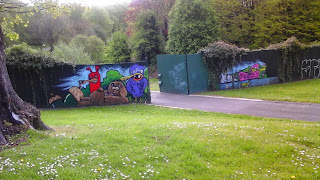The
Corrymeela Diaries
Day 4
and beyond
Wifi
seems to be down in many parts of London and which has delayed my last post. Here’s a final reflection from this year's journey …
Below
are a couple of pictures from our final 24 hours at Corrymeela. One with jazz
hands and silly faces (although some missed the memo on that one), and one “for
the record.”
Sessions
throughout the week took us deeper into the history and work of Corrymeela
during the past 50 plus years. We had conversations with Karin Eybin, Community
Famiily Worker, about her work with citizen engagement in several communities.
In
addition to specific content sessions, participants are encouraged to have conversations
with those at the centre during meal and break times … the many volunteers,
young and old, from around the world, the visitors at the centre, whether for a
day or a week, and the various staff people who are part of the community. Sometimes
we learn as much from our conversations “around the edges” as we do in the
content sessions.
Tuesday
evening Paul began our sessions on peace and reconciliation by posing the
question “how can we learn to live apart well?” At St. John’s this year many
have spent some time studying the dynamics of conflict, how we personally
respond to conflict, and how we can learn to still be in relationship with
people with whom we profoundly disagree.
In
order to get the conversation going amongst the leaders at St. John’s, I
circulated an article from the Congregational Consulting Group that suggested
that healthy congregations seek out conflict instead of trying to avoid it.
That got some interesting comments! The idea is that by seeking out “conflict”
in a congregation, we are really uncovering diversity, and encouraging the deep
listening that is necessary to bridge the gap of stereotypes, misunderstanding,
and competing narratives.
This
has been the work of peacemaking in Northern Ireland for decades. Folks like
Paul, Karin, Sean, Padraig, and Michael Doherty, who we met on Wednesday on our
trip to Derry/Londonderry, have been mediating and facilitating conversations
between different groups in the hopes that in the conversation a path will be
found that will lead to living together with respect. Not always agreement. But
acceptance, respect, and good relations. Below are a couple of pictures of our
time in Derry as we walked the walls with Michael.
During
the week we were also blessed to welcome into the group long term volunteer
Kendal, from Colorado, and Alejandra, from Columbia, who is a student at York
University (England) doing a two month internship at Corrymeela. Both young
women were a rich addition to our group conversations. They also managed to
take care of all of our physical needs, from getting our tea and coffee ready
at break time, to ordering us a cab for the Wednesday evening pub run to
O’Connor’s or the Thursday afternoon trip to the Giant’s Causeway.
It
always seems like the time is too short at Corrymeela. Before we knew it, we
were back in Belfast, enjoying Spanish tapas Friday night for dinner, and then
having our final evaluation session on Saturday morning before folks went their
separate ways. As is often the case, folks talked about the unexpected and
profound insights that they experienced, both personally and in approaching the
conflict in Northern Ireland with new insights.
As
always … the journey continues … with blessing, challenge and much gratitude. Until the next time ...
















